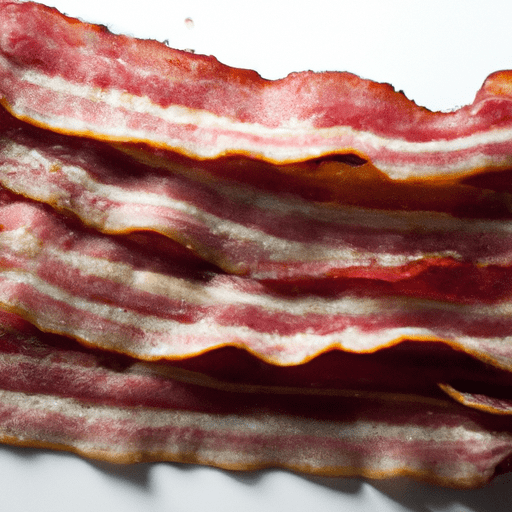The Marvelous World of Thick-Cut Bacon
If there’s one thing that can instantly awaken your senses and bring a smile to your face, it’s the sizzling sound and irresistibly savory aroma of thick-cut bacon cooking on a lazy Sunday morning. Bacon has become a beloved breakfast staple that has made its way into countless dishes, from sandwiches to salads. But there’s something special about thick-cut bacon that takes this culinary delight to a whole new level. In this article, we’ll explore the amazing world of thick-cut bacon, from its taste and common uses to its nutritional value and fascinating history.
The Taste that Transcends Boundaries
Thick-cut bacon stands apart from its thinner counterparts in more ways than one. With its generous thickness, this bacon boasts a perfect balance of crispy exterior and juicy interior. When cooked to perfection, the result is a mouthwatering symphony of rich, smoky flavors that will leave you craving for more.
Versatility at its Best
Thick-cut bacon isn’t just limited to breakfast. Its robust flavor profile makes it an excellent addition to a wide range of dishes. It can elevate a classic BLT sandwich to extraordinary heights or add an extra dimension to a creamy pasta carbonara. Additionally, it can be wrapped around chicken breasts or asparagus spears and baked to perfection, creating an irresistible combination of flavors and textures.
Nutritional Value: The Good and (a bit of) the Bad
While bacon may not be the epitome of health food, when enjoyed in moderation, it can still be a part of a balanced diet. Thick-cut bacon is a source of protein, iron, and vitamin B12. However, it’s important to remember that bacon is also high in saturated fat and sodium, so it’s best consumed in moderation, together with other nutrient-rich foods.
A Historical Culinary Journey
Bacon has been a beloved culinary delight for centuries. Its roots can be traced back to ancient times when the Chinese began to preserve pork bellies with salt. In Europe, bacon became a staple food in the diets of many, particularly in cultures where pigs were readily available. In America, bacon became widely popular during the early 20th century, thanks to the rise of industrial meat processing techniques.
Fun Facts About Thick-Cut Bacon
Here are a few interesting facts to ponder while cooking and enjoying thick-cut bacon:
- The United States is the largest producer and consumer of bacon in the world.
- Different countries have their own prized variations of bacon, such as the Italian pancetta or the Spanish jamón.
- In 2003, John Daley built the world’s largest strip of bacon, measuring a whopping 4,501 feet long.
- Bacon-infused cocktails, such as the famous Bloody Mary, have gained popularity as creative twists on classic drinks.
Embrace the Indulgence
Thick-cut bacon offers a world of culinary possibilities, from its mouthwatering taste to its versatility in the kitchen. Remember to savor it in moderation as part of a balanced diet and explore various recipes to unlock its full potential. Whether you’re a bacon lover or a curious food enthusiast, let this delectable treat add some savory joy to your culinary adventures.
So go ahead, grab a few slices of thick-cut bacon, fire up that skillet, and embark on a culinary journey that will make your taste buds dance with delight. With its tantalizing flavor and endless possibilities, thick-cut bacon is a true culinary marvel that deserves a prominent place in your kitchen.
Origin: Thick-cut bacon is a popular variation of bacon, which itself has a rich history. Bacon can be traced back to ancient times, with evidence of preserved pork dating back to the ancient Chinese and Roman civilizations. The specific origin of thick-cut bacon is unclear, but it likely developed as a result of variations in butchering techniques and regional preferences for thicker slices.
Common uses: Thick-cut bacon is a versatile ingredient used in various culinary applications. It is frequently enjoyed as a breakfast staple, where it is often pan-fried or cooked in the oven until crispy. Thick-cut bacon is also commonly used as a flavorful addition to sandwiches, burgers, salads, and numerous savory dishes, providing a smoky, salty, and fatty flavor profile.
Nutritional benefits: Bacon, including thick-cut bacon, is a good source of several essential nutrients. It is a significant source of protein, providing all nine essential amino acids required by the body. Bacon also contains important vitamins and minerals, including B-vitamins, zinc, selenium, and phosphorus. However, it is important to note that bacon is also high in saturated fat and sodium, so moderation is key when consuming it.
Unique properties and historical significance: Thick-cut bacon has its own distinct properties compared to thinner slices. The thickness allows for a balance between achieving crispiness and retaining a meatier texture. Its rich flavor and versatility have made it a favorite among chefs and home cooks alike. Bacon, in general, holds cultural and historical significance in various cuisines. It has been used as a flavor enhancer and an ingredient in traditional dishes across many cultures throughout history. In recent years, thick-cut bacon has gained popularity due to its ability to add a bold and delicious element to dishes.




Use the share button below if you liked it.
It makes me smile, when I see it.